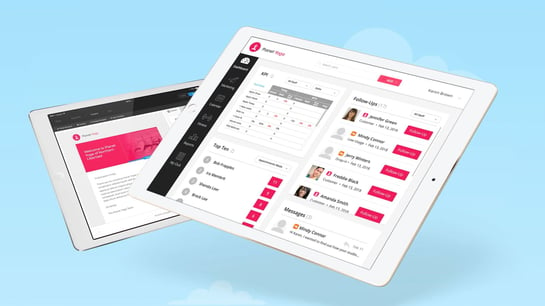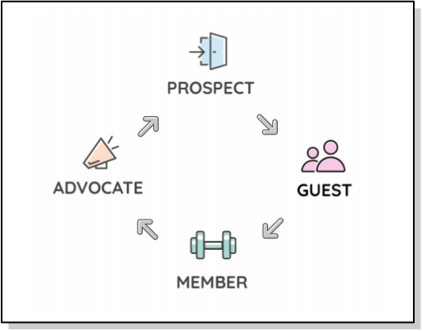
The lifeblood of any club is its membership. Maintaining a robust and engaged member base keeps a fitness business viable long term. Clubs simultaneously must have effective pathways for nurturing leads into sales-ready prospects and a mapped out engagement plan to keep members invested in their services. It’s a lot of work for a full team, much less a single-owner operation, to keep track of and execute effectively in between daily gym duties.
That’s where a CRM or Customer Relationship Management software comes into play. The right CRM will organize, unify, and simplify the sales and retention process.
Organize: Input and track sales goals; map out prospect-member lifecycle.
Unify: One sales tool to replace redundant workflows and softwares.
Simplify: Automate touchpoints, eliminate manual data entry, and utilize automatic follow-up schedules.
Prospect-Member Lifecycle
There are four major stages in the prospect-member lifecycle. The first is when a new lead is identified and becomes an official prospect. The second is when a prospect accepts a guest pass or trial to the gym. The third is when a prospect purchases a membership and becomes a member. The fourth is when the member, having experienced the value of the club’s services, becomes an advocate for the gym and generates new referrals. These referrals in turn enter stage one as new prospects and the cycle is repeated.

A club’s software should be utilized at each step to maximize the sales and retention opportunities.
Stage One: Prospect
The prospect-member lifecycle begins each time a new prospect is identified. However, not all prospects are created identically. New leads are typically generated through one of three major pipelines.
Walk-Ins: A prospect whose first contact with the club is physically walking into the location and inquiring about rates and services.
Telephone Inquiries: A prospect whose first contact with the club is via a phone call to ask about rates and services.
Web Leads: A prospect whose first contact with the club is via an online medium, e.g. club website, social media accounts, or third party partner softwares.
Without a CRM
Paper-Oriented Lead Capture: Prospect information is recorded in paper guest registries, notebooks, scrap paper, or sticky notes.
Redundant Data Entry: Prospect information is manually re-entered from paper forms to master lead lists or prospect spreadsheets.
Manual Reach Outs: Club staff work through spreadsheets of prospects or handwritten lists to perform follow-ups.
With a CRM
Digital Guest Waiver: Walk-in prospects enter their information using the club tablet(s) into the digital guest waiver.
New Lead Form: Prospects who inquire via telephone have their information entered directly into the software using the new lead form.
Web Leads: Prospects captured online through the club website, social media, or partner software are automatically funneled into the software.
The Difference
Unified Collection Point: Prospects generated through multiple entry points are collected into one central location, the club’s CRM. Staff can review and contact any leads quickly through the software as opposed to juggling three or more prospect lists.
Reduced Data Entry: Capturing lead information on paper requires redundant data entry as it must be transferred to prospect spreadsheets or master lists versus one-time entry into a CRM. Further, prospect profiles are created automatically and convert seamlessly to member profiles when the sale is finalized in the software.
Automated Touchpoints: Web leads receive automatic email responses when they request more information for a club online. Automated responses reduce the wait time between inquiry and first contact. Club staff follow automated messages with personal reach outs to schedule appointments.
Stage Two: Guest
While some prospects contact a gym fully intending to purchase a membership, most need time to evaluate if its facilities and services are right for their fitness goals and lifestyle. This is where guest passes, also known as trial memberships, come into play. A trial period gives potential new members a chance to explore a club without the pressure of a sales appointment. Likewise, this time is invaluable to club staff as a chance to engage and incentivize a purchase.
Without a CRM
Manual Tracking: Staff log guest pass start and end dates on a shared calendar or sticky notes in order to track upcoming trial expirations.
Hand Counted Numbers: Staff hand count guest pass records to verify current numbers of trial members.
Non-Automatic Data Transfers: Staff rely on handwritten notes from the sales appointment to assess a guest’s needs and wants in a gym membership.
With a CRM
Usage Tracking: Each guest check-in is logged in the system for later reference and for all staff to access.
Guest Pass Expiration Notification: The system alerts staff to expiring guest passes and prompts reach outs to discuss membership options.
Ongoing Follow-ups: If a guest does not purchase a membership by the end of their trial period, they are placed within a missed opportunity follow-up schedule.
The Difference
Data Driven: Notes recorded during a guest’s original sales appointment are stored on their profile and easily accessed. Staff use check-in records to confirm a guest has visited the club and inquire if their experience met their needs as recorded during the sales appointment.
Long-Term Strategy: Guest prospects are placed into the club’s follow-up schedule for reach outs during their trial and beyond. Staff periodically follow-up with guests who opted not to purchase a membership to offer promotional rates or discuss new club services. This prevents expired guests from being lost in the shuffle as new guests visit the club and increases the likelihood of eventually landing the sale.
Expiration Alerts: Staff are alerted to guest passes expiring 24 hours before, so they can reach out and schedule an appointment to discuss membership options. This empowers staff to proactively convert guests rather than relying on the prospect to contact them.
Stage Three: Member
Once a prospect purchases a membership, successful gyms focus on two main objectives with new members: retention and engagement. Here, retention refers in a general sense to basic administrative tasks, such as tracking inactivity, delinquencies, and pending expirations. Engagement refers to ways clubs deepen their relationship with members, such as offering additional services (classes or Personal Training), hosting club-wide events, or providing enrichment amenities (free assessments). The more engaged a member becomes, the higher their probable retention level grows.
Without a CRM
Manual Audits: Member inactivity, delinquencies, and pending expirations require rigorous manual tracking by club staff.
In-Club Signage: Club events and new services are advertised using in-club signs posted to gym walls and community boards.
Front Desk: Front desk staff inform members of upcoming events and services as well as update them on membership delinquencies or pending expirations.
With a CRM
Payment Monitoring: Members who are past due on monthly payments are flagged in the system, which initiates a reach out by assigned staff and/or an automated email alerting the member to the delinquency.
Enhanced Communication: Staff are able to email and text members through the software as well as log completed phone calls for later reference. Blast emails enable mass communication with membership while automated emails keep members up-to-date on important changes in their accounts.
Inactivity Alerts: Members who surpass the club’s inactivity threshold, preset number of days without a check-in, are flagged in the system, which initiates a reach out by assigned staff and/or an automated email encouraging the member to visit the club.
The Difference
Fewer Outstanding Payments: Delinquent invoices are flagged and stored for easy reference to prevent a swell in outstanding debt. Staff follow regular scheduled reach outs to delinquent members until payment is received.
More Informed Membership: While in-club signs and front desk staff can make a big dent in informing members of club events or discrepancies on their account, their influence cannot extend beyond the club’s front door. CRM software empowers club staff to contact members through a variety of methods and at the most important times.
Increased Member Accountability: By tracking inactivity, clubs are able to provide higher accountability to members. Personalized or automated messages that encourage inactive members to visit the club boost attendance and retention rates.
Stage Four: Advocate
When a member is fully engaged in a gym, its services, and its culture they become advocates. Member advocates speak positively about their club experience and refer family and friends as new leads. Successful clubs incentivize advocacy through referral bonuses and make referral entry as accessible and smooth as possible.
Without a CRM
Paper-Oriented Referral: Capture Staff record referral information on paper forms, notebooks, scrap paper, or sticky notes.
Manual Follow-Ups: Club staff work through a referral spreadsheet or list to perform reach outs.
Referring Member Follow-Up: After a successful referral, responsible staff verify the referring member and reach out to discuss their referral bonus.
With a CRM
Quick Referral Entry: Staff are able to enter referrals through multiple portals within the software, which reduces unnecessary navigation.
Linked Accounts: The referring member’s profile is linked to the referral to establish a digital paper trail for later reference.
Automated Email Response: Referring member receives an automated email notifying them of a successful referral.
The Difference
Reduced Data Entry: Referral information captured on paper leads to redundant data entry as it must be transferred to prospect spreadsheets or master lists versus one-time entry in a CRM. Further, the software uses this information to automatically create a referral prospect profile.
Automated Touchpoints: Referrals are placed within the club’s follow-up schedule. Staff use this schedule to make regular reach outs until an appointment is scheduled with the referral.
Enhanced Notification: Automated email notifications sent to referring members outline their earned referral bonus, such as a free month of membership, and how to claim it. Ensuring referring members are rewarded incentivizes future referrals.
Bonus: Personal Training (PT) Lifecycle
When a new member joins a club, they become eligible to take advantage of its training services. This initiates the PT prospect-member lifecycle, which is focused on the same two goals as the prospect-member lifecycle: sales and retention. Club sales are boosted through personal and group training services while a member’s probable retention level increases with each new service they purchase.
Without a CRM
Orientation: New members are offered an orientation with a club trainer. This is a free fitness consultation in which the trainer suggests club programs that can help them meet their fitness goals.
Manual Billing: PT clients pay each invoice manually in the club when they arrive for training.
Package Auditing: Trainers manually audit client packages to track remaining sessions and ensure generated invoices have been paid.
With a CRM
PT Status: Prospects are assigned PT statuses which indicate how far along they are in the PT prospect-member lifecycle.
Automated Payments: Recurring training invoices automatically bill using client credit card or bank account information.
Opportunity Alerts: PT clients whose training packages dip below the club’s opportunity threshold, a preset amount of remaining training sessions, are flagged in the system which initiates a reach out by assigned staff to discuss package renewal options.
The Difference
Targeted Follow-Ups: Prospects are assigned PT statuses based on how far along they are in the PT prospect-member lifecycle. Staff utilize status information to focus reach outs on progressing prospects to the next step.
Reduced Past Due Invoices: Automated payments eliminate the need to manually process invoices in club. This ensures payments are taken on time, reduces staff bookkeeping, and allows clients to start training immediately upon arrival.
Increased Renewals: Opportunity alerts enable trainers to begin renewal conversations before a client exhausts all available training sessions. This gives clients time to prepare financially for the upcoming purchase and prevents unnecessary lapses in training.
Overview
Making changes to how you sell and retain members doesn’t have to be hard, scary, or feel like the great unknown. Everything you need to know is right here. We hope that you take the information in this blog and find ways that your fitness business could increase revenue and retention.